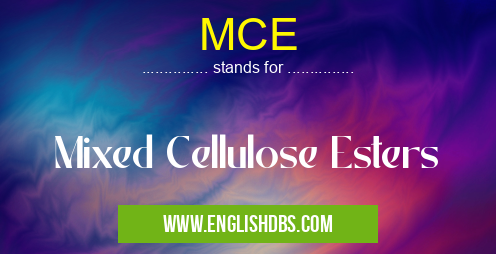What does MCE mean in UNCLASSIFIED
MCE, an abbreviation that stands for Mixed Cellulose Esters, holds significance in various industries. This acronym represents a group of cellulose derivatives that possess unique properties and find applications in diverse fields.

MCE meaning in Unclassified in Miscellaneous
MCE mostly used in an acronym Unclassified in Category Miscellaneous that means Mixed Cellulose Esters
Shorthand: MCE,
Full Form: Mixed Cellulose Esters
For more information of "Mixed Cellulose Esters", see the section below.
Definition
Mixed Cellulose Esters are chemically modified forms of cellulose, a natural polymer abundant in plant cell walls. These esters are synthesized by treating cellulose with a mixture of acids, typically acetic acid and butyric acid, to introduce acetyl and butyryl groups into its structure. This modification alters the physical and chemical properties of cellulose, making it soluble in organic solvents and imparting enhanced performance characteristics.
Properties
MCEs exhibit several notable properties that contribute to their industrial utility:
- Solubility in Organic Solvents: MCEs are soluble in a wider range of organic solvents compared to pure cellulose, which makes them suitable for use in various applications such as coatings, inks, and adhesives.
- Film-Forming Ability: MCEs can form flexible and transparent films when dissolved in organic solvents. These films possess good mechanical strength and resistance to moisture and chemicals.
- Thermal Stability: MCEs exhibit excellent thermal stability, making them resistant to heat and degradation at elevated temperatures.
- Biodegradability: MCEs are biodegradable materials that can be broken down by microorganisms in the environment, contributing to their environmental friendliness.
Applications
The unique properties of MCEs have led to their widespread use in a variety of industries, including:
- Coatings: MCEs are used in coatings for wood, metal, and plastics, providing protection against corrosion, moisture, and wear.
- Inks: MCEs are employed in the formulation of printing inks, offering improved printability, adhesion, and durability.
- Adhesives: MCEs are utilized as binders in adhesives, enhancing their bonding strength and resistance to solvents.
- Membranes: MCEs are used in the production of microporous membranes for filtration and separation applications.
- Films: MCE films are employed in packaging, electronics, and medical devices due to their transparency, strength, and barrier properties.
Essential Questions and Answers on Mixed Cellulose Esters in "MISCELLANEOUS»UNFILED"
What are Mixed Cellulose Esters (MCE)?
Mixed Cellulose Esters (MCE) are a group of cellulose derivatives that have been chemically modified to improve their properties and expand their applications. They are typically made by reacting cellulose with a mixture of carboxylic acid anhydrides, such as acetic anhydride and propionic anhydride. The resulting material has a mixed ester structure, with both acetyl and propionyl groups attached to the cellulose backbone.
What are the properties of MCE?
MCEs possess a unique combination of properties, including:
- Hydrophilic and Hydrophobic Regions: They have both hydrophilic (water-loving) and hydrophobic (water-repelling) regions, making them suitable for applications in both aqueous and non-aqueous environments.
- Chemical Resistance: They are resistant to many chemicals, including acids, bases, and solvents.
- Thermal Stability: They have high thermal stability and can withstand temperatures up to 150°C.
- Biocompatibility: They are biocompatible and non-toxic, making them suitable for use in medical and pharmaceutical applications.
What are the applications of MCE?
MCEs have a wide range of applications, including:
- Membranes: They are used in filtration membranes for water purification, dialysis, and other separation processes.
- Coatings: They are used as coatings for metal, plastic, and other surfaces to improve their corrosion resistance and other properties.
- Biomaterials: They are used in medical implants and devices due to their biocompatibility and ability to promote cell growth.
- Pharmaceuticals: They are used as excipients in drug formulations to improve solubility, stability, and bioavailability.
Final Words: MCE, short for Mixed Cellulose Esters, represents a class of cellulose derivatives that exhibit tailored properties through chemical modification. Their solubility in organic solvents, film-forming ability, thermal stability, and biodegradability make them valuable materials in various industrial applications, including coatings, inks, adhesives, membranes, and films.
MCE also stands for: |
|
| All stands for MCE |
